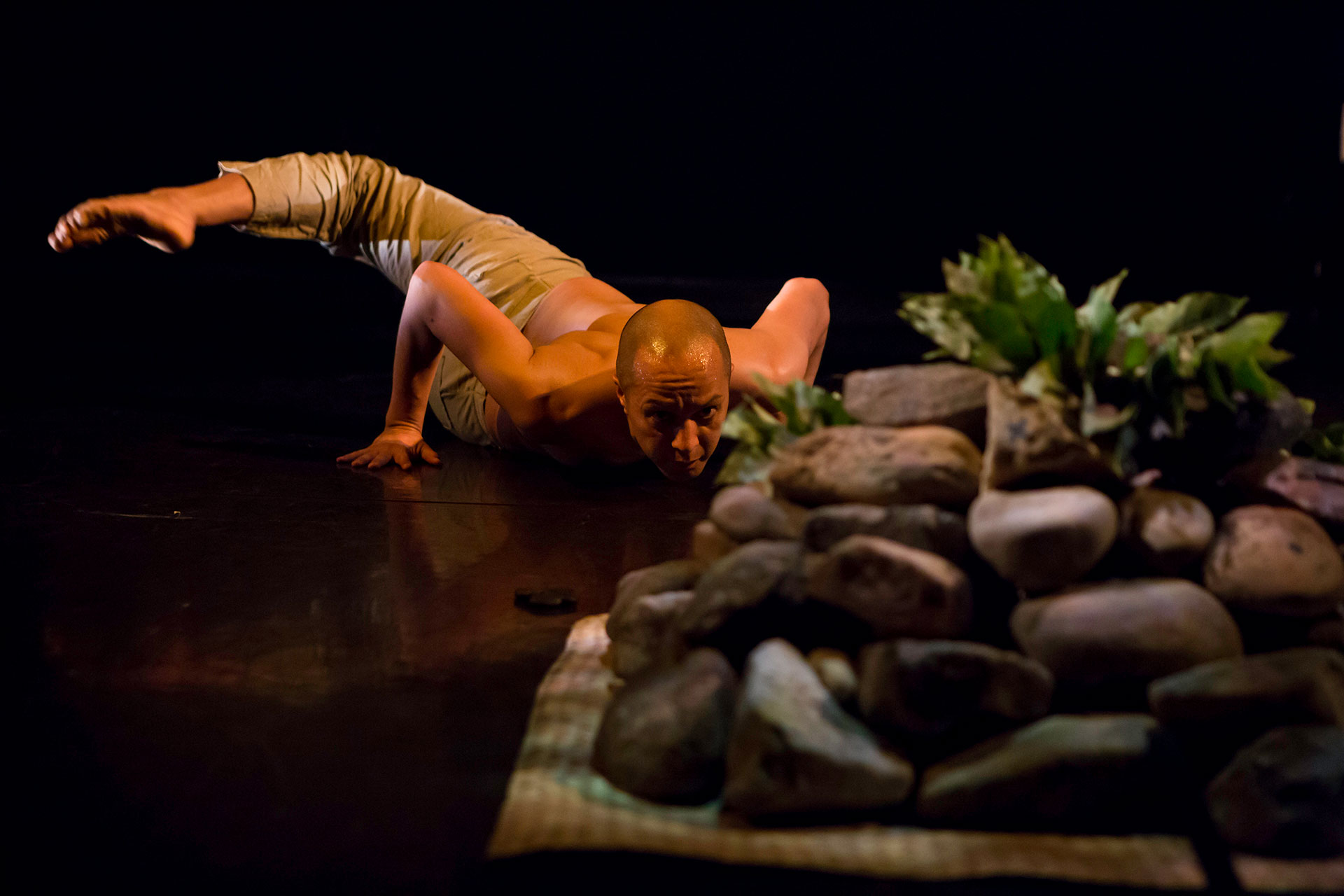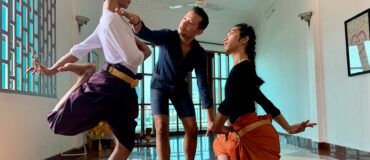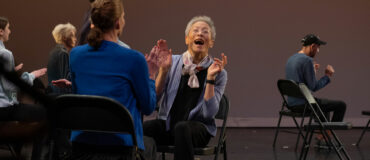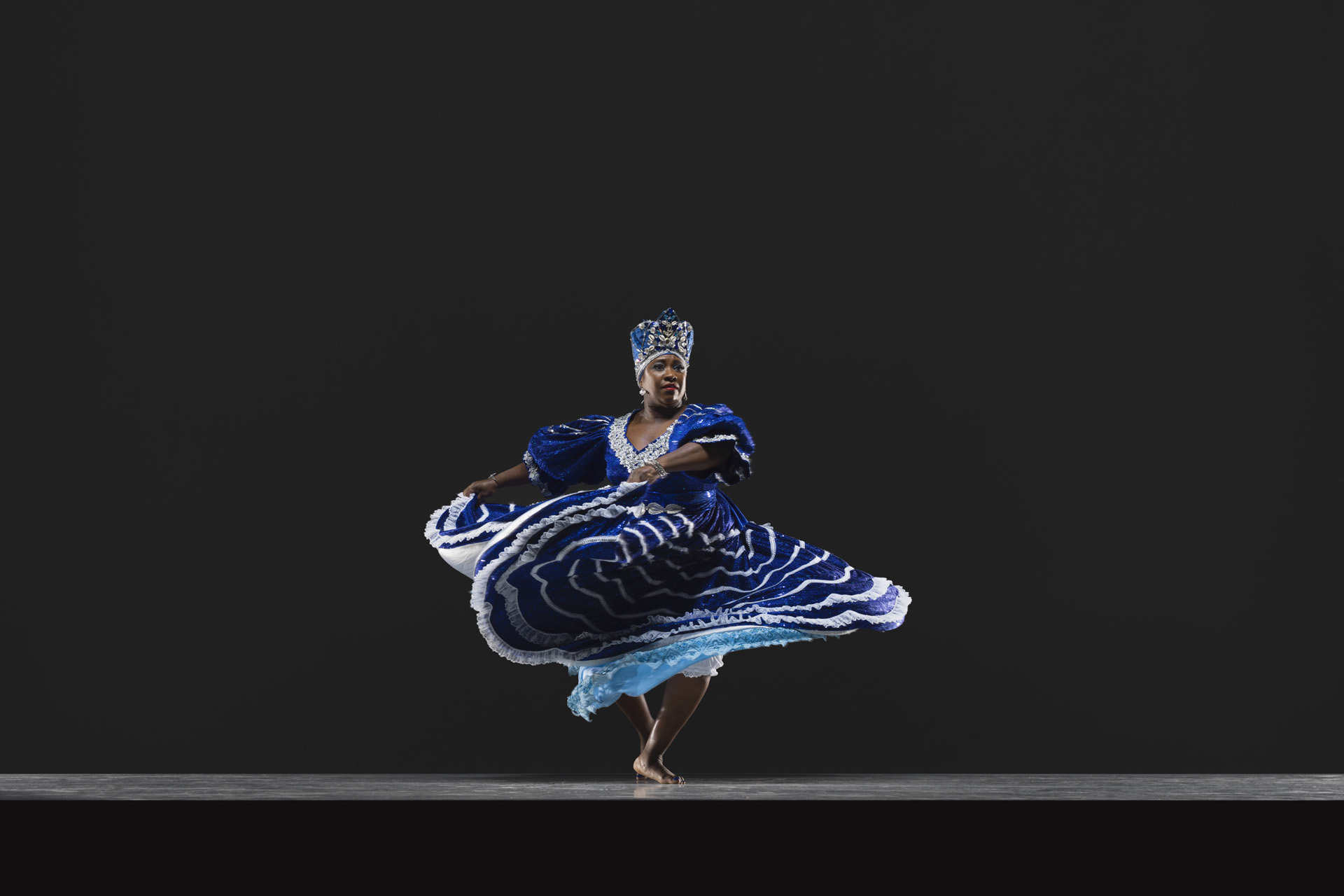Community Builders: Transmission and Legacies of Immigrant American Artists
Community Builders: Transmission and Legacies of Immigrant American Artists
Assane Konte, Charya Burt, and Naomi Diouf
By Rob Taylor
Editor’s note: This article is one of 11 in a series examining the creative work of 31 dance artists funded by Dance/USA Fellowship to Artists, generously supported by the Doris Duke Charitable Foundation. These artists’ practices are embedded in social change as they work in multiple dance forms in communities across the country.

A master teacher, Assane Konte’s annual African Dance Conference in Washington, D.C., is a three-day intensive filled with instruction in traditional dance and drumming allowing students to immerse themselves in the complex rhythms and embodied histories of West African cultures. Photo: Lawrence Green
Assane Konte, Charya Burt, and Naomi Diouf are master artists who are immigrants to the United States. As culture-bearers within their respective communities, they create works of significant artistic and cultural value and have spent decades in their adoptive country creating communities of practice around their culturally specific dance forms — from Cambodia, Liberia and Senegal, respectively. Although their dance communities are now multi-generational and firmly rooted in specific American locales, these three artists — who sustain the art and culture of their homelands — draw a solid line connecting their cultures of origin to the communities they founded in the U.S.
Seen through this lens, these dance forms are part of a larger cultural transmission process that can include music, foodways, apparel, belief systems, and different forms of personal and social engagement. Consummate professionals, these three creatives have dedicated their lives to dance. Within the process of cultural transmission, a performance is just one stop on a complex journey — a journey where immigrants share and sustain and innovate their cultural dance inheritance as part of larger community-building efforts within U.S. communities. The opportunity to learn from this generation of culture bearers working on American soil is an opportunity to see how traditional dance holds relevance to new communities of practice.
Assane Konte

Konte founded KanKouran West African Dance Company in 1983 to showcase the essence of traditional African dance and music to American audiences. While the company preserves traditional music and dance from the Senegambia region of Africa, in works like 2014’s Sounougal, Konte also innovates. Photo: Lawrence Green
Assane Konte is a dancer, choreographer, costume designer, and community leader who came from Senegal to the United States, where he formed KanKouran West African Dance Company in 1983. Konte has led his company through 36 years of artistic creation and what he describes as “asset building” in Washington, D.C. Through a multi-pronged organization that includes children, teen, and adult performing groups, Konte has built a village in the Washington, D.C., area based around West African culture that provides his individual dancers with a stronger sense of shared heritage and community identity. He has also worked to share the beauty of his form through annual performances in Poland, Hawaii, Japan, and St. Croix, and through educational postings at many Washington, D.C.-area universities, including Howard, Georgetown, George Washington, and American. Konte produces a nationally attended annual dance conference and concert, which he terms the oldest continuing African dance conference in the United States, now in its 37th year. The conference brings together both African dance masters from around the country to build community and share ideas, as well as practitioners who build relationships with teachers and fellow dancers year after year.
Charya Burt
 - crop medium.jpg)
Charya Burt has dedicated her life to mastering the 4,000-plus gestures of the Cambodian classical dance vocabulary. Burt stages near-forgotten dances while also remaining culturally relevant to contemporary audiences. In Caressing Nostalgia, above, she looks with gratitude to the past. Photo: RJ Muna
Charya Burt came to the United States in 1993 from Cambodia and settled in Windsor, a small town north of Santa Rosa, Calif. Since that time, she has worked to connect Cambodian communities, using dance as a medium of cultural connection and community identity. She has worked diligently to educate the San Francisco Bay Area dance audience about Khmer classical dance with her performing company, Charya Burt Cambodian Dance. A central component in Burt’s work has been to sustain Cambodia’s dance culture, which was nearly wiped out after the Khmer Rouge genocide murdered nearly one-third of Cambodians and almost all the nation’s artists. She is committed to preserving the “nearly 4,000-plus gestures and movements that compose the vocabulary of Khmer classical dance, along with the sacred dances that make up the classical repertory.” However, she has also expanded her performance repertoire to create original works that incorporate other artistic traditions and new innovations that she has been exposed to over the years. Her company has performed this work at diverse venues, including the San Francisco Ethnic Dance Festival, the Oregon Shakespeare Festival, Jacob’s Pillow, and other community art spaces.
Naomi Diouf

Naomi Diouf in the “Dancing Over 50 Project” told interviewer Emmaly Wiederholt about her motivation to continue dancing: “Dance heals the body and mind. It’s a beautiful thing to feel life’s music in your body. Dance is your feeling made visible.” Photo: Gregory Bartning
Naomi Diouf, who is based in Oakland, Calif., emigrated to the U.S. from Liberia to become artistic/managing director of Diamano Coura West African Dance Company founded by her husband Dr. Zak Diouf (who is from Senegal) in 1975. As Burt told me in our interview, “When you see Naomi and Zak walk, you can see that they carry tradition.” This lineage is reflected in the company’s name, Diamano Coura, which means “those who bring the message” in Senegal’s Wolof language. Naomi and Zak Diouf, recognized earlier this year as National Endowment for the Arts Heritage Fellows, are leaders in the Bay Area African and African Diaspora communities as messengers of West African dance and drumming forms. They have mentored hundreds of individuals, building community through West African cultural practices. Diamano Coura has performed at dance festivals in San Francisco, Houston, Atlanta, and toured throughout the country on multiple occasions, as well as organizing an annual performance that includes other Bay Area African and African Diaspora companies. Like Konte, since 1995 Diouf and her husband have produced an annual conference Collage des Culture Africaines, which she describes as a homecoming: “It’s a place for master artists [from around the U.S., as well as from Africa] to discuss issues around African dance, and an opportunity to teach students to get exposure to African dance — things we can’t discuss from afar.”
Being Oakland-based is important to Diouf. She first settled in Southern California, but said, “I heard the Bay Area was a cultural hub. I heard so much about the diversity and the richness of different cultures in the Bay Area. Oakland was a Black community, and my first experiences in L.A. were with a good group of Black dancers. They said to me, ‘You’re from Africa … teach us about culture.’ When I came to the Bay Area, I had that focus in mind. And they needed me more, because I felt that many groups were unable to access African culture [here].”
FORGING U.S. DANCE COMMUNITIES WITH AN IMMIGRANT PERSPECTIVE
For these artists, education means passing on their cultural art forms and is as important as performance. They each have their own way of conveying their respective traditions and forms to students, and their experiences as immigrants have impacted how they do that.
As he has settled in the U.S., Konte has developed a process for teaching dancers that is different than the training system that he experienced growing up. He shares: “In Africa we don’t have dance classes, they just put you in the dance company and they put you to the side for a year or until they see if you are ready. You have to learn it on your own …. People don’t just get up and say, ‘I want to be a dancer,’ like here …. So [when] I got here, I had to relearn everything I teach, because here you have to train people.” In Konte’s experience, in the U.S., “You may not have the gift, but I can train you.” He finds that he works more closely with students to help them learn choreography and the correct execution of body movements.
“I am an African woman dancer,” Diouf declares to me when I ask how being an immigrant impacts her work. “I already have a narrative. I have the stories I bring with me. I have all the little sayings that are important to me and I incorporate them into my classroom, my teaching, my choreography, and my company,” she states. This self-knowledge is valuable because she draws on her lived experience to help connect her students and dancers to dance traditions through her personal stories and experiences as an African woman dancer.
As a dancer and teacher who frequently works with Cambodian immigrants, Burt is hopeful for the future of Cambodian dance in the U.S. She tells me that she hopes people will remember her as a dance artist who not only worked hard to preserve Cambodian traditional dance, but also created work that is relevant to today’s world — work that continues to help Cambodians heal.
HEALING COLLECTIVE CULTURAL TRAUMA
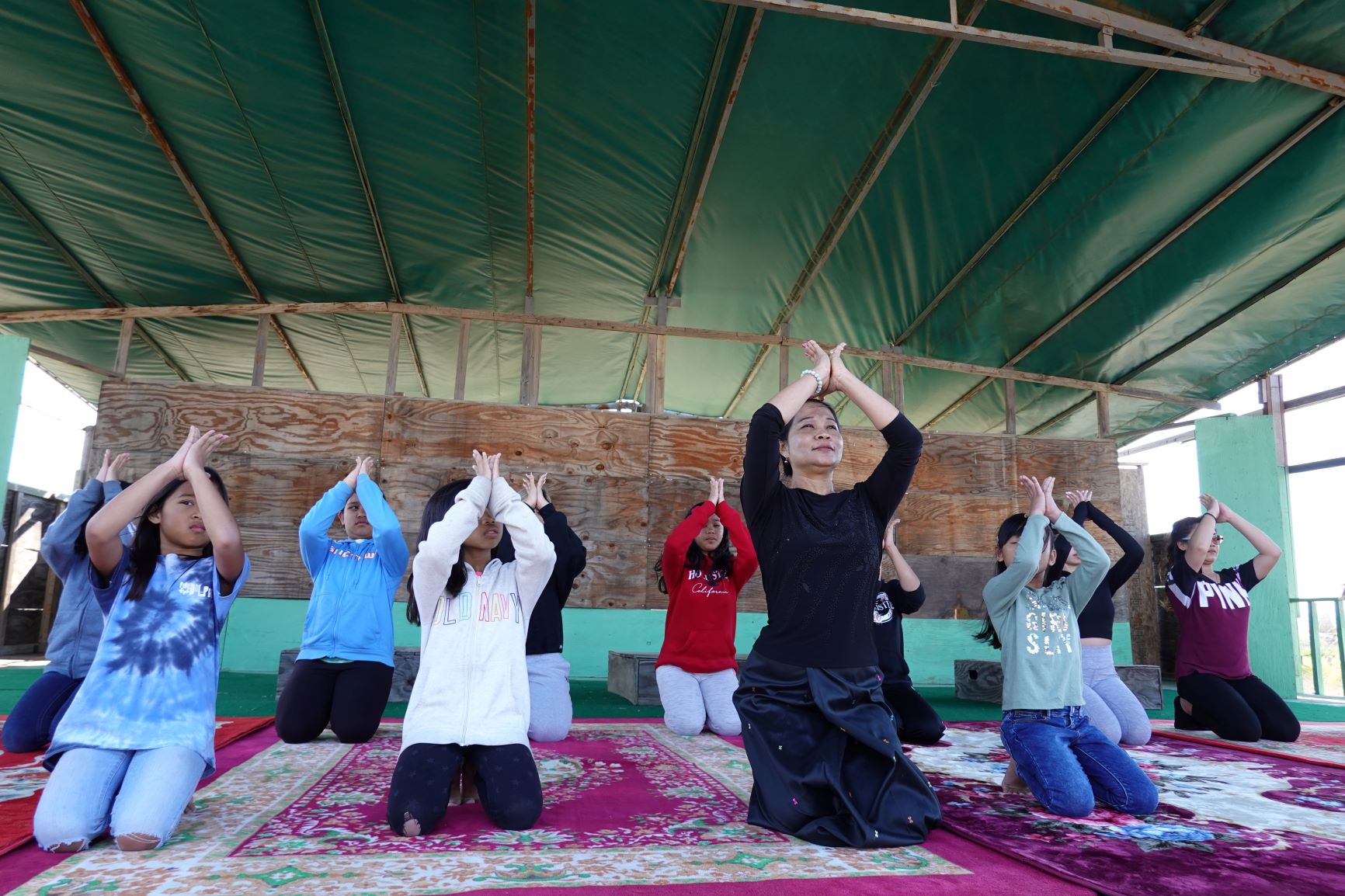
Burt leads a community engagement workshop with the Wat Khmer Modesto Dance Group for a group of children at the Wat Cambodian Buddhist Society in Modesto, Calif. She aims to impart traditional Cambodian dance forms to a new generation on new soil. Photo: Rob Burt
That healing is very personal for Burt. Cambodian national dance symbolized the national identity but was almost destroyed by the oppressive Communist Khmer Rouge, which ruled from 1975 to 1979. During that time the regime forced the evacuation of Cambodian cities, building re-education camps where many urban intellectuals, writers, and artists were executed along with ethnic minorities, among them members of Burt’s family. “My father, my two brothers, and 90 percent of Cambodian artists were killed,” she shares, “so I feel a great obligation to keep these traditions alive. I’m obligated to continue to teach to new generations.” Creating new work is also a part of that obligation. She balances between preserving the traditional dance forms she learned in Cambodia and creating new works within that tradition, using innovative combinations of theatrical storytelling, singing, and film.
Collective trauma is something that both Diouf and Konte address within their communities. As Diouf explains, “I came to the United States and encountered … numerous African-Americans coming out of social movements like the Black Power Movement hungry for knowledge about African culture.” She states that 70 percent of her students suffer from trauma, and that “a goal of Diamano Coura is to be a consistent place with structure, nurturing, and a curriculum that ‘meets them where they are.’”
From his youth in Senegal, Konte understood “the impacts of racial injustice … and experiencing the struggle of self-determination in the face of colonization.” But when he came to the United States, he said he saw “African-Americans experiencing similar struggles, but without the bolstering of deeply rooted identities and connections to something larger than their American experience and portrayals.” KanKouran was created to preserve West African culture, but also to build community utilizing the tools of traditional dance and music to provide a pathway for his students — often young African-Americans — to succeed. Konte says his training “stresses family values, sharing, and working together.” In addition, students are required to have completed college before they can move into the professional performing company at KanKouran. He says, “When you don’t know who you are — you’ve got a problem. You feel bad about yourself; everything is a trap.” The training and community found in KanKouran becomes a means for building identity for the next generation.
DYNAMIC TENSION: INNOVATION IN TRADITIONS
The notion that traditional dance is immovable or rigid discounts how adaptive it must be to survive over time and circumstances. Many traditional artists grapple with sustaining their dance form in the U.S. when outside of their natural contexts. The questions of whether to make changes to the movement vocabulary or music, or any other critical aspect of practice when performing in a western context, remains a challenge to many of these master artists. The three artists illustrate different ways of mixing tradition with innovation.
Konte sees tradition as what he does best. “I’m going to stick to my tradition.” However, he acknowledges that presentation matters and he re-frames his dances to take advantage of the proscenium stage. “You can’t go to the theater and make it look like you’re in the streets dancing. You need to let people know what it is.” From Konte’s perspective: “Our art form is more like musical theater, it tells our history, and you have got the whole thing on the stage.”

Diamano Coura West African Dance Company in Oussouye — The King Awaits You, by next-generation African/American choreographer Danielle Delane. Diouf both preserves her ancestral past and nurtures a next generation of leaders and choreographers. Photo: Cindy Manly-Fields
Diouf also draws from musical theater to describe how western audiences can approach West African dance. She says, “You’re telling a story of our culture through dance.” While she and her company have remained firmly attached to the traditional forms, re-set for the stage, like Konte, Diouf has partnered with other artists to incorporate traditional West African movements into western dance forms. The most notable case is her and her husband’s collaboration with choreographer Val Caniparoli on “Lambarena” for the San Francisco Ballet. Set to Johann Sebastian Bach and West African music, the dance has been re-staged by the Pacific Northwest Ballet, Singapore Ballet, and the Ballet of Florida.
Burt has fully embraced the concept of cross-cultural collaboration in her original works, which she says are “deeply rooted in tradition, but use a range of styles — theatrical use of different music styles, using live singing spoken word, and spoken word and video presentation, and shaping and molding traditional movements and gestures.” For example, her work “Blue Roses,” took the character of Laura from Tennessee Williams’ The Glass Menagerie and reconfigured the story into a tale of a Cambodian princess, using Cambodian classical dance movements to convey the cloistered life of Williams’ heroine.
In speaking with these three artists, I noted similarities that link them together despite their different cultural lineages and geographic distances. The most striking attribute was their strength and certitude in their identities. The thriving cultural communities that they have built and maintained in the United States are havens away from home and work or school, where people can gather, celebrate, be supported, learn, grow and connect.
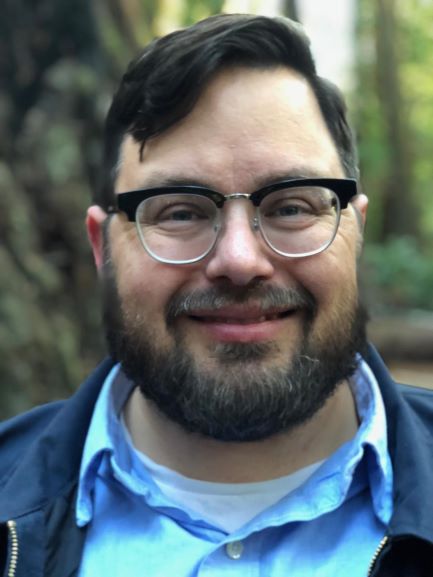
Rob Taylor has worked for many years with the San Francisco Ethnic Dance Festival with artists from more than 400 cultural communities. This experience led him to write more than 30 articles about different culturally specific dance artists in the San Francisco Bay Area that were published in In Dance, a publication of Dancers’ Group, a service organization dedicated to the dance community in the greater Bay Area. He has a B.A. and M.A. in history from San Francisco State University.
Please visit the artists’ websites: Charya Burt, Mama Naomi Diouf, and Assane Konte. Readers may read and print a PDF version of this article here. Readers may visit and share this article on Medium here. Find more information on the DFA Article Series here and more information on Dance/USA Fellowships to artists here.
____
We accept submissions on topics relevant to the field: advocacy, artistic issues, arts policy, community building, development, employment, engagement, touring, and other topics that deal with the business of dance. We cannot publish criticism, single-company season announcements, and single-company or single artist profiles. Additionally, we welcome feedback on articles. If you have a topic that you would like to see addressed or feedback, please contact communications@danceusa.org.
Disclaimer: Opinions expressed in guest posts do not necessarily represent the viewpoints of Dance/USA.
